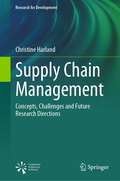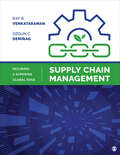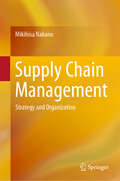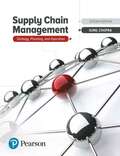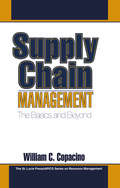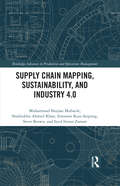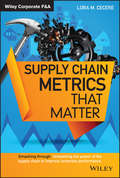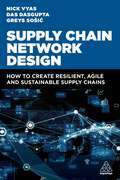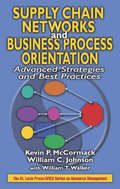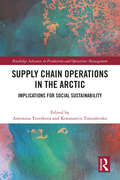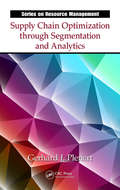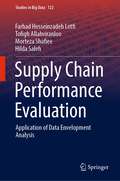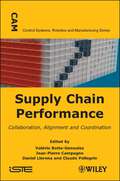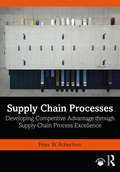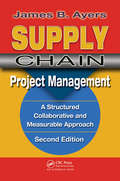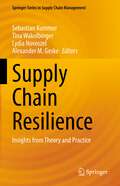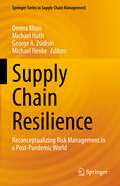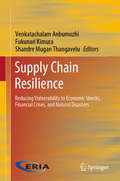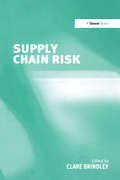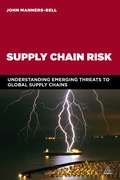- Table View
- List View
Supply Chain Management: Concepts, Challenges and Future Research Directions (Research for Development)
by Christine HarlandThe book focuses on the development of the concept of supply chain management and the current state of knowledge on supply chain structure and infrastructure. It draws together knowledge from materials management, purchasing and supply management, operations management, industrial marketing and logistics perspectives, as well as industrial economics, organizational behaviour, systems thinking, and strategic management. Three key conceptual themes are developed: (1) the recognition of supply chain management as a multi-level endeavour, (2) the increasing aspirations for supply chain management to be a strategic, not just an operational concept, and (3) the view of the supply chain management research community as an academic discipline. The book also examines supply chain structure in terms of dyads, triads, chains, networks, supply bases, supply systems and supply markets. Supply chain infrastructure is discussed in terms of processes, roles and behaviours, and draws on extensive international empirical research. Challenges for researchers are addressed, such as interconnectedness in complex supply systems, the need for greater resilience, and how public policy and public value can be impacted by research. It concludes with a co-authored chapter that examines the potential future identity of supply chain management.
Supply Chain Management: Securing a Superior Global Edge
by Ray R. Venkataraman Ozgun C. DemiragSupply Chain Management: Securing a Superior Global Edge takes a holistic, integrated approach to managing supply chains by addressing the critically important areas of globalization, sustainability, and ethics in every chapter. Authors Ray Venkataraman and Ozgun C. Demirag use a wide variety of real-world cases and examples from the manufacturing and service sectors to illustrate innovative supply chain strategies and technologies. With a focus on decision-making and problem-solving, Supply Chain Management provides students with the tools they need to succeed in today’s fiercely competitive, interconnected global economy. Included with this text The online resources for your text are available via the password-protected Instructor Resource Site. Learn more.
Supply Chain Management: Securing a Superior Global Edge
by Ray R. Venkataraman Ozgun C. DemiragSupply Chain Management: Securing a Superior Global Edge takes a holistic, integrated approach to managing supply chains by addressing the critically important areas of globalization, sustainability, and ethics in every chapter. Authors Ray Venkataraman and Ozgun C. Demirag use a wide variety of real-world cases and examples from the manufacturing and service sectors to illustrate innovative supply chain strategies and technologies. With a focus on decision-making and problem-solving, Supply Chain Management provides students with the tools they need to succeed in today’s fiercely competitive, interconnected global economy. Included with this text The online resources for your text are available via the password-protected Instructor Resource Site. Learn more.
Supply Chain Management: Strategy and Organization
by Mikihisa NakanoThis book explains supply chain management (SCM) using the strategy–structure–process–performance (SSPP) framework. Utilizing this well-known framework of contingency theory in the areas of strategic management and organizational design, SCM is firmly positioned among management theories. The author specifically proposes a theoretical foundation of SCM that will be relevant to such areas as operations management, logistics management, purchasing management, and marketing. Both the static and dynamic sides of SCM are reported. On the static side, supply chain strategies are divided into three patterns: efficiency-oriented, responsiveness-oriented, and the hybrid efficiency- and responsiveness-oriented pattern. For each strategy, suitable internal and external supply chain structures and processes are proposed. On the dynamic side, the big issue is to overcome performance trade-offs. Based on theories of organizational change, process change, and dynamic capabilities, the book presents a model of supply chain process change. On structure, the focus is on the role of an SCM steering department. Illustrative cases are included from such diverse industries as automobiles (Toyota and Nissan ), personal computers (Fujitsu), office equipment (Ricoh), air-conditioning (Daikin), tobacco (Japan Tobacco), chemicals and cosmetics (Kao), and casual fashion (Fast Retailing and Inditex).The strategy and organization of SCM is systematically presented on the basis of the SSPP framework. In particular, the relationships among three management elements—strategy, structure, and process—can be identified in an SCM context. From many of the cases contained in this volume, there emerges an understanding of how to analyze the success and failure factors of SCM using the SSPP framework. In addition, the reader sees not only the static side SCM such as process operation but also its dynamic side such as process innovation and process improvement.
Supply Chain Management: Strategy, Planning, And Operation
by Sunil ChopraSupply Chain Management introduces high-level strategy and concepts while giving you the practical tools to solve supply chain (SC) problems. Using a strategic framework, the text covers all of the key drivers of performance, including facilities, inventory, transportation, information, sourcing and pricing. New cases in the 7th Edition illustrate how good SC management offers a competitive advantage and how poor SC management can damage an organization's performance. With this text, you'll gain a deeper understanding of SCs and how managerial levers can improve SC outcomes.
Supply Chain Management: The Basics and Beyond
by William C. CopacinoFrom one of the world's leading consultants, authors and practitioners in the area of supply chain management comes the most extensive coverage of the subject to date. Bringing more than 18 years of experience in logistics, manufacturing, purchasing, customer service, and supply chain management in a wide variety of industries, William Copacino offers his unique insight and recommendations in Supply Chain Management.This important book provides an overview of all areas of supply chain management in a concise yet informative style. Any busy executive or manager looking to deepen his or her understanding of supply chain management will find this efficient reading.Ideal for manufacturers, service companies, suppliers, distributors and retailers in consumer product, electronic, automotive, pharmaceutical and medical product industries. Provides strategies, tools and techniques for both executives and managers in production, purchasing, inventory control, customer service, distribution and accounting. Academicians will find it fits the growing needs of students studying business and especially production/operations management.
Supply Chain Mapping, Sustainability, and Industry 4.0 (Routledge Advances in Production and Operations Management)
by Steve Brown Muhammad Shujaat Mubarik Sharfuddin Ahmed Khan Simonov Kusi-Sarpong Syed Imran ZamanDuring the COVID-19 pandemic, supply chain (SC) mapping appeared as one of the critical SC capabilities that could make a striking difference in organizations’ SC performance and improve sustainable operations. Despite its crucial role in responding to SC disruptions, there is a void in the literature on this topic. This book aims to address this gap demonstrating the importance of SC mapping, sustainability in the Industry 4.0 era. The book explores how SC mapping contributes to sustainability from social, economic, and environmental perspectives, the role of SC mapping in upstream, midstream, and downstream SC sustainability, as well as the role of technology advancement and the impact of blockchain and Industry 4.0 in SC mapping. Adopting a multidisciplinary approach, this edited collection features international authors from a diverse range of disciplines including SC management, operations management, technology and innovation management, and sustainability. The book will be a valuable resource for global scholars, researchers, and upper-level students across operations, SC management, and logistics, as well as engineering and technology management.
Supply Chain Metrics that Matter
by Lora M. CecereHow to Conquer the Effective Frontier and Drive Improved Value in Global OperationsGrowth has slowed. Volatility has increased and the world is more global. Brands are defined by innovation and services. Supply chain excellence matters more than ever. It makes a difference in corporate performance.One cannot snap their fingers and deliver supply chain success. It happens over the course of many years. It is measured in inches not miles. In this book, the author evaluates the progress of over a hundred companies over the period of 2006-2013.Success drives value. The effective supply chain makes a difference in winning a war, saving a patient, and driving commerce; but it also makes a difference in a community having clean air, potable water, and a standard of living. Mistakes are hard to overcome. Supply Chain Metrics that Matter tells this story. The book links corporate financials to supply chain maturity. In the book, the author analyzes which metrics matter.The author Lora M. Cecere is a supply chain researcher as well as an authority in supply chain technology. She helps companies gain first mover advantage. In the book, Cecere provides concrete, actionable steps to align and balance the supply chain to drive value. The book explores the crossover between supply chain efficiency and financial growth with topics such as:Outlining the metrics that matter, the metrics that don'tProgress in industry sub-segment in improving inventory, cash, productivity and marginThe management techniques that improve performanceSharing insights on how metrics change as the supply chain maturesThe roadmap to improve performance. Today, supply chains are global and dynamic. They are rapidly evolving. Companies that constantly seek out new solutions and opportunities for improvement drive differentiation. In a market where growth is stalled and many companies are stuck in driving supply chain performance, this book provides a clear, concise framework for a more modern, effective supply chain.
Supply Chain Network Design: How to Create Resilient, Agile and Sustainable Supply Chains
by Nick Vyas Dr Das Dasgupta Professor Greys SošicThe traditional linear supply chain is no longer fit for purpose, and organizations must redesign their supply chains to become more customer-driven, agile, resilient and sustainable.Supply Chain Network Design shows how to design intelligent, agile supply chain networks in the age of geopolitical disruptions, fast-paced technological innovation and drive for more sustainable business. It outlines how to incorporate international relations and a global perspective into supply chain planning and actions and how to embed ESG and circular economy goals. It surveys the rapidly evolving technology landscape and how it impacts some companies and provides a competitive advantage to others. It also explores how to harness technologies such as robotic process automation, AI and machine-driven intelligence and the evolution of forecasting to demand sensing to enhance network design.Taking a global perspective, Supply Chain Network Design is supported by practical cases and examples and provides a consumer-driven lens that will help organizations evolve their networks from a traditional B2B to a B2B2C workflow. Covering both lessons learned and how to move forward, this will be an must-read for supply chain, logistics and distribution leaders, managers and analysts.
Supply Chain Networks and Business Process Orientation: Advanced Strategies and Best Practices (Resource Management)
by William C. Johnson Kevin P. McCormackWith future competitive landscape shifting from competition between companies themselves to trading partner networks, understanding and mastering process design and change is becoming more critical than ever. In order to succeed, companies are starting to weave their key business processes into hard-to-imitate strategic capabilities that distinguis
Supply Chain Operations in the Arctic: Implications for Social Sustainability (Routledge Advances in Production and Operations Management)
by Antonina Tsvetkova Konstantin TimoshenkoThe extant corpus of research on supply chain sustainability in the Arctic exhibits a conspicuous neglect of the social dimension, rendering it the most underprivileged among the three pillars of sustainability. A deep dive into the Arctic, this edited volume endeavors to fill this opulent lacuna by placing the unjustly forsaken concept of social sustainability at the forefront of supply chain management (SCM) research. By showcasing real-life case studies of supply chain operations, all in different industries and located in various Arctic regions, this book delves into the intricate interplay between business interests, political ambitions, and social issues. In response to the burgeoning demand for more in-depth empirical studies within the SCM landscape, it offers a compelling tapestry of experiences and candid views on the complexities of implementing socially sustainable and responsible policies in Arctic supply chains. Featuring contributions by 26 esteemed scholars worldwide, this collection proffers 13 thought-provoking and insightful chapters, arranged in a logical and coherent sequence that enables readers to follow a clear thread of argumentation. With abundant theoretical insights and empirical data, Supply Chain Operations in the Arctic: Implications for Social Sustainability will appeal to a wide range of readers keeping a close eye on Arctic operations and sustainable issues. It is a timely and essential resource for students and scholars of SCM and sustainability studies, as well as businesses, policymakers, Indigenous Peoples, and non-governmental organizations seeking to promote socially responsible supply chain practices in the Arctic.
Supply Chain Optimization at Hugo Boss (A)
by Ananth Raman Nicole Dehoratius Zahra KanjiWe evaluate the impact of a supply chain pilot implemented at Hugo Boss. This pilot entailed altering the way in which Hugo Boss orders from its suppliers. We explore the challenge of assessing the impact of supply chain change, the link between operational performance and firm performance, and the relationship between sales, inventory, and product availability.
Supply Chain Optimization through Segmentation and Analytics (ISSN)
by Gerhard J. PlenertSupply Chain Segmentation (SCS) has become a critical tool in optimizing supply chain performance. By using segmentation, an organization is taken out of the world of one size fits all and brought into a world that facilitates customized responses. This book explains what SCS is, how it works, and the role of analytics. The book gives detailed case studies demonstrating how SCS is applied and improves efficiency. It covers software appropriateness and integration, as well as a full summary perspective on segmentation and its competitive impacts in terms of economic pressure, supplier and consumer interfaces.
Supply Chain Partners: Virginia Mason and Owens & Minor (A) (Abridged)
by V. G. Narayanan Lisa BremOwens & Minor (O&M) performed lean inventory services for Virginia Mason (VM) as its alpha vendor, but the outdated industry pricing model created perverse incentives and could not capture O&M's costs. Together, O&M and VM created an activity-based pricing model called the total supply chain costs (TSCC), which incented both companies to be more efficient and to streamline their distribution activities. After beta testing the TSCC for one year, VM's Daniel Borunda and O&M's Michael Stefanic believed that TSCC was a better and more cost-effective pricing model, but could they convince their companies to continue to invest in TSCC?
Supply Chain Partners: Virginia Mason and Owens & Minor (B)
by V. G. Narayanan Lisa BremThe epilogue to Supply Chain Partners: Virginia Mason and Owens & Minor (A), the B case details the outcome of the issues discussed in Case A; namely that Virginia Mason and Owens & Minor did implement the TSCC contract. Virginia Mason also kept the suture contract with O&M because the TSCC model was able to prove that O&M was the low-cost provider. Case B also gives results metrics, such as reduction in line items, orders, and days sales outstanding.
Supply Chain Performance Evaluation: Application of Data Envelopment Analysis (Studies in Big Data #122)
by Tofigh Allahviranloo Farhad Hosseinzadeh Lotfi Morteza Shafiee Hilda SalehThe authors of this book tried to make these experiences available to those interested, considering the experience of several years of training, research, and implementation of projects in the supply chain performance evaluation field.This book intends to identify the current performance and competitive position of that supply chain compared to other supply chains by presenting and reviewing the techniques and models for measuring the efficiency and performance of the supply chain. Determining the performance of a supply chain is a good description of the status quo (what is). Determining the performance of a supply chain is useful for describing the past and present of supply chain processes, and on the other hand, it can be used to set performance goals and initiate the improvement process. To realize this, a strategic framework or model is needed to be able to extract indicators related to the efficiency of the supply chain and design the appropriate model.
Supply Chain Performance: Collaboration, Alignment and Coordination
by Valérie Botta-Genoulaz Daniel Llerena Claude Pellegrin Jean-Pierre CampagneThis book examines the opportunities for, and the effects and benefits of, collaborative working practices and their impact on supply chain performance. The first part of the book focuses on modeling the supply chain using conceptual frameworks to describe the relationship between collaboration and performance. The second part examines the issues around information systems alignment, and ensuring the management and coordination of interactions with suppliers and customers. The final part focuses on the various different formalized approaches that may be taken to analyze the impact of any given collaboration process, coordination mechanism, or decision-making behavior.
Supply Chain Processes: Developing Competitive Advantage through Supply Chain Process Excellence
by Peter W. RobertsonSupply Chain Processes introduces readers to the view that genuine supply chain competitive advantage is achieved via supply chain excellence which in turn is underpinned by supply chain process excellence. The ultimate supply chain goal is to deliver the right product, of the right quality, in the right quantity, to the right place, at the right time and for the right cost. The author identifies four core supply chain processes – strategy, design, execution and people – to which the process improvement techniques explained can be applied to ensure superior supply chain performance. Key topics are addressed, including supply chain risk, resilience, sustainability, challenges confronting modern-day supply chains and developing an elegant supply chain design. Each chapter starts with a section that explores learning opportunities and is followed by detailed chapter content. Carefully explained examples are provided, as well as end of chapter case studies, review questions and written assignments. A full suite of teaching aids is also provided for lecturers and tutors. Providing both management expertise and technical skills, which are essential to decision-makers in the supply chain, this textbook should be essential reading for undergraduate and post-graduate students, working people or mature aged persons wanting to upgrade their qualifications, and operating supply chain leaders and supply chain professionals. Online resources include chapter-by-chapter PowerPoint slides, tutorial exercises, written assignments and a test bank of exam questions.
Supply Chain Project Management.
by James B. AyersImproving supply chain efficiency, especially in an unsettled business climate, requires that managers go beyond doing business as usual. They must apply inspiration and perspiration in a structured, collaborative, and measurable approach that blends project management with supply chain management knowledge and practice.Supply Chain Project Ma
Supply Chain Resilience: Insights from Theory and Practice (Springer Series in Supply Chain Management #17)
by Sebastian Kummer Tina Wakolbinger Lydia Novoszel Alexander M. GeskeEvery global crisis highlights the strategic importance of industrial and non-profit supply chains for society. In terms of coping with unforeseen and unpredictable events, supply chain resilience enables the parties and networks involved to stay successful during and after the disruption. Furthermore, a resilient supply chain contributes to the sustainable competitive advantage of the entire value chain. Written by scholars and practitioners alike, this book not only puts forward a new framework for resilience in supply chain management, but also presents best practice cases from various areas and industries. As a particular highlight, it includes a Delphi study that gathers state-of-the-art insights from supply chain leaders. In addition to practical approaches, methods and tools, the book also offers food for thought on the future of supply chain resilience. As such, it offers a valuable resource for current and future managers in the public and private sector, as well as researchers and students engaged in this field.
Supply Chain Resilience: Reconceptualizing Risk Management in a Post-Pandemic World (Springer Series in Supply Chain Management #21)
by Michael Huth Omera Khan George A. Zsidisin Michael HenkeThis book provides insights from research and practice in how organizations were able to sustain resilience in their global supply chains during the COVID-19 pandemic and to advance the understanding of supply chain risk management. The chapters highlight the lessons learned, insist on new models for resilience, suggest improved supply chain risk methodologies and bridge the gap between research and practice. It helps readers acquire greater knowledge, strategic approaches, new methods, and practical tools for ensuring global supply chain resilience.
Supply Chain Resilience: Reducing Vulnerability to Economic Shocks, Financial Crises, and Natural Disasters
by Venkatachalam Anbumozhi Fukunari Kimura Shandre Mugan ThangaveluThis book investigates individual companies’ and industries’ supply chain risk management approaches to identify risk drivers and verify effective risk-reduction measures and business continuity plans.Typically, supply chain risk assessments focus on normative guidelines based on single best practice examples or vulnerability events, and there has been little work exploring how the concepts of supply chain risk management and resilience are related. However, since this relationship has implications for developing integrated response strategies, a clear understanding of the possible consequences is a fundamental step in building socio-economic resilience along the supply chain.Against this background, the book addresses three main topics: firstly, it defines the conceptual and sectoral domains of supply chain risk management and resilience by examining the welfare effects of extreme weather events and other economic shocks on selected global supply chains. It then presents an in-depth analysis of the scope of public–private partnerships to tackle the risks, by empirically exploring supply chain risk effects and information management. Thirdly, it proposes a regional cooperation framework in the context of major supply chain vulnerability events such as disasters and global financial crises.
Supply Chain Risk
by Clare BrindleyThe impact of technological change, globalization, information and communication technologies and international governmental intervention has radically altered supply chain strategies, operations and risk profiles for most organizations. The challenge facing business and researchers alike is how best to address risk management in this new context. This collection, written by international scholars from the UK, US and Scandinavia, addresses this need by providing the first topical review of these developments and the latest research findings. The findings represent a robust cross-disciplinary view of supply chains, articulating policies and strategies for organizations. The research studies are based on empirical case studies within services and manufacturing in both large and SME organizations. This work is intended to provide the foundation for future research in this expanding area and the impact it has on managing risk within the supply chain.
Supply Chain Risk
by John Manners-BellSupply Chain Risk assesses the various sources of external threat to the supply chain, including environmental, geopolitical, economic and technological. John Manners-Bell clearly describes the evolving risks to supply chains and how multinational corporations should be dealing with them at a strategic level. He examines the lack of supply visibility which puts businesses at risk and includes case studies of best practice, as well as citing examples of when and how things go wrong. Each case study describes a company's supply chain and production/ sourcing strategy; a description of the catastrophic event which occurred; consequences to supply chain and management response; material losses incurred and resultant changes to company supply chain strategy.
